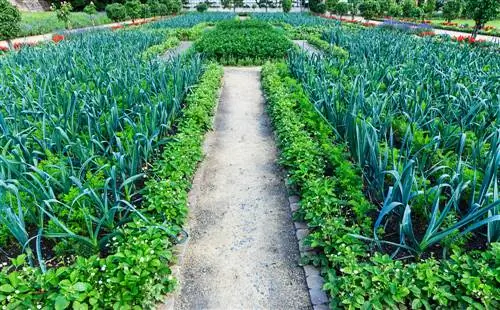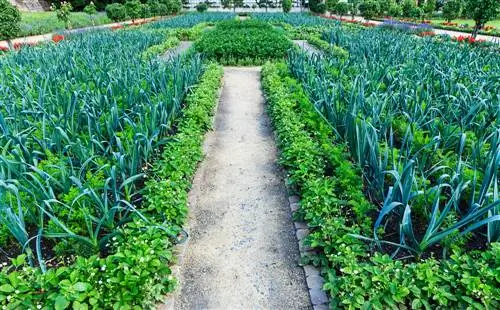- Author admin [email protected].
- Public 2023-12-16 16:46.
- Last modified 2025-06-01 06:02.
Alliances can be formed among the plants in this database to unite to ward off diseases and pests. Anyone who is familiar with how a mixed culture works will benefit from the convincing advantages in the home garden. This guide explains the exact procedure of the organic farming strategy. Familiarize yourself with the connections here and get to know proven plant coalitions that complement each other perfectly as neighbors.

What is mixed culture and what advantages does it have?
Mixed culture is the joint cultivation of different plant species that have a positive influence on each other and support each other in growth, yield and he alth. The advantages of mixed culture are better nutrient and water utilization, disease and pest resistance, and preservation of soil fertility.
What is meant by mixed culture? - Explanation of terms for practitioners
Mixed culture as an ingenious cultivation method results from precise observations in untouched nature and practical experiences from ecologically oriented home gardeners. However, scientific research on this topic is still in its infancy, so the findings and procedures are based predominantly on empirical data. As the term suggests, the socialization of different plants has a beneficial effect on growth, productivity and he alth in the kitchen garden. The following definition sums up the findings surrounding mixed culture:
Mixed culture is the joint cultivation of different types of plants that have a positive influence on each other
In the long version, this definition says that plants can support each other, despite different requirements for nutrient and water supply. Different rooting depths ensure that plants in a mixed culture do not interfere with each other. Rather, local resources are used perfectly without leaching the garden soil. The concentration of root exudates, root residues and escaping odors strengthens the defenses against diseases and pests in harmony with nature. To put it simply, the motto 'Opposites attract' is transferred from the human search for a partner to the planting plan for the vegetable garden.
Monoculture - dark antagonist with chemistry in its luggage

If you plant too much of one variety in one spot, you often can't avoid using chemicals
A look at the principles of monoculture illustrates the outstanding importance of mixed culture for growing plants according to ecological principles. The cultivation of plants with identical botanical classifications has numerous negative effects. To compensate for this, commercial agriculture uses chemical aids. The use of pesticides and artificial fertilizers as well as other methods that are harmful to the environment and he alth are commonplace in monoculture fields.
Tip
To ensure that only the advantages of mixed culture can be realized in your home garden, important requirements must be taken into account. Choose a location that is suitable for all plants. Dig the garden soil two spades deep and incorporate compost, bark humus or manure. Consistently avoid using artificial fertilizers and chemical pesticides so that the colorfully mixed plant community can optimally exploit its natural strengths.
To good neighbors - dream teams of mixed culture
The prime example of a successful association of crops according to the principle of mixed culture is the carrot and onion duo. The carrot effectively repels onion flies, while the onion repels approaching carrot flies. In other alliances, the benefits go one way because one plant sacrifices itself for the other. Horseradish attracts approaching Colorado potato beetles so that potato plants remain unmolested. The following table introduces you to proven dream teams in the kitchen garden that benefit each other:
| Mixed Culture | Good neighbors | Beneficial effect |
|---|---|---|
| cabbage | Tomatoes | Protection against cabbage fly, coal owl, flea beetle |
| Tomatoes | parsley, onions | Repel late blight pathogens |
| Potatoes | Horseradish | Repels Colorado potato beetles |
| Cucumbers | Peas | Natural windbreak |
| Beans | Corn | Natural climbing aid |
| Corn | Beans | Nitrogen enrichment and soil aeration |
| Leek | Strawberries | Defense against gray mold spores |
| Strawberries | Borage | Promotion of flower buds and fertilization |
Another important premise for successful mixed culture is that the neighboring plants do not shade each other. Therefore, ensure there is sufficient planting distance if you choose one of these floral coalitions. Horseradish, for example, can perfectly fulfill its role as a natural bulwark against Colorado potato beetles if the plant is located in each of the four corners of the potato bed, far away from the shadow-casting potato leaves.
Colorful flowers and aromatic herbs - ideal companion plants for mixed cultivation
The strategic implementation of a mixed culture in the kitchen garden does not mean that you have to do without colorful flowers or aromatic herbs. The following flower beauties also make useful neighbors in the vegetable garden:
- Tagetes: Promoting Soil He alth
- Lily of the valley: Healing effect on brown blight and late blight
- Coneflower: defense against snails
- Marigolds: repelling wireworms, bean aphids and nematodes
- Sweet lupins: enriching the soil with nitrogen
Where chives join vegetable plants, fungal infections have a bad chance. The ethereal root exudates effectively ward off cunning fungal spores. Chamomile ensures that bed neighbors build up a stable defense against diseases. Where nasturtiums thrive, whiteflies, lice and ants take flight.
Bad neighbors - conflicts are inevitable here
The other side of the mixed culture coin is unfavorable plant combinations. Not all useful and ornamental plants maintain a harmonious neighborhood, but rather interfere with each other's growth and vitality. Therefore, please do not combine your plant favorites randomly, but research carefully in advance how they are compatible with your neighbors. The following vegetable plants, among others, are not suitable for mixed cultivation:
| Bad Neighbors | ||
|---|---|---|
| Beans | Peas, carrots, leeks, tomatoes, cucumbers | |
| Cucumbers | Beans, lettuce, beetroot, tomatoes | |
| Potatoes | Tomatoes, peas, celery, beetroot, onions | |
| Tomatoes | Potatoes, beans, peas, cucumbers, onions, beetroot | |
| Carrots | Beetroot | |
| Beetroot | Carrots, cucumbers, potatoes, spinach, tomatoes |
The aversions within incompatible plant combinations even extend beyond the immediate neighborhood. It is not recommended to grow cucumbers after carrots because the soil can be contaminated by nematodes. Cucumbers are also not suitable as a crop rotation for potatoes, due to the risk of remaining wilt fungi in the soil.
Balcony gardeners like to grow strawberries in flower boxes. In the sense of mixed culture, marigolds and marigolds are colorful neighbors, whereas tulips attract various pests, such as wireworms and nematodes.
Practical example of a vegetable patch in mixed culture
The following practical example illustrates how the concrete implementation of mixed culture in your own kitchen garden works. We have created a planting plan for a total of 4 beds from popular plants in this database. These are cultivated in mixed culture with the aim of providing a family of four with delicious, he althy vegetables from spring to late autumn. The beds have a work-wise advantageous width of 1.20 m and are separated by 30 cm wide paths.

Cabbage and lettuce have a positive effect on each other
In bed 1, plant your favorite types of cabbage, such as rose, red, cauliflower or white cabbage, in 3 rows. There is a row of plants in the middle of the bed. Place the other two rows 10 cm away from the edge of the bed. The planting distance within a row is 50 cm. Since it takes some time for cabbage to fill the space, put early lettuce and early kohlrabi in between. You have harvested these plants long before cabbage closes the rows.
In bed 2, plant bush beans, kohlrabi and celery. The planting distance within the rows is 50 cm. The rows themselves are spaced at a distance of 40 cm, as these types of vegetables do not thrive as extensively as cabbage in the bed 1.
Cucumbers, lettuce and early kohlrabi should thrive in bed 3. Just plant a row of cucumbers in the middle of the bed, 30 cm apart. Since the planting season for cucumbers doesn't begin until mid-May, use the area until then with two additional rows of your favorite lettuce variety. Early kohlrabi and lettuce act as border plants.
For bed 4, tomatoes, peppers and hot peppers are planned as the main crops, supplemented with radishes, lettuce, cress and spinach as secondary crops. At the beginning of April, sow spinach in 4 rows or plant early-grown young plants on the windowsill. Garden cress, lettuce and radishes follow at the end of April. You harvest these plants after 6 weeks, when spinach takes up more area. The spinach plants have to go in mid-May because the planting time for tomatoes, peppers and hot peppers begins. Place tomato plants in the two middle rows. The two outer rows are intended for peppers and hot peppers. In the middle of the main rows, sow parsley, marigolds and marigolds for mixed culture.
Tip
If conspecifics from different genera meet in the bed, plant he alth and yield suffer. Classic examples of fatal neighborhoods are cruciferous vegetables, legumes and umbelliferous plants. Therefore, avoid a mixed culture of brassicas, such as cauliflower, Brussels sprouts or kale. Peas, beans and sweet peas don't get along, nor do carrots, dill and celery.
Mixed culture for advanced users - How to include crop rotation
After some time, if you are familiar with the basic functionality of mixed culture, you can still optimize the cultivation principle. For this purpose, the planting plan includes the correct crop rotation of the crops. In concrete terms, this means that from year to year the bed planting changes between weak, medium and heavy feeders so that the soil does not become depleted. Annual crop rotation guarantees that soil fertility is maintained, which significantly reduces the need for fertilizers. The following table explains how it works:
| Crop rotation | Bed 1 | Beet 2 | Beet 3 | Beet 4 |
|---|---|---|---|---|
| 1. Year | Green swell | Heavy eaters | Middle eaters | Weak eater |
| 2. Year | Heavy eaters | Middle eaters | Weak eater | Green manure |
| 3. Year | Middle eaters | Weak eater | Green manure | Heavy eaters |
| 4. Year | Weak eater | Green manure | Heavy eaters | Middle eaters |
Typical heavy eaters include cabbage, potatoes, tomatoes, corn, beans and spinach. Peas, radishes, onions, leeks, celery, carrots and spinach are considered medium-food sources. Salads, almost all herbs and garden cress are considered weak eaters. However, the boundaries are fluid. Various classifications are controversial among gardeners. In this context, green manure has the task of regenerating the garden soil and preparing it for next year's planting with heavy feeders.
The art of implementing mixed culture with crop rotation is to include all aspects, including nutrient requirements, in the planting plan. Accordingly, the carrot/onion duo as medium feeders follows the dream team of corn/beans from year to year in order to live on what the heavy eaters left in terms of nutrients.






